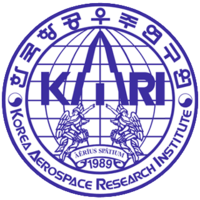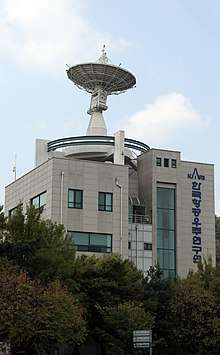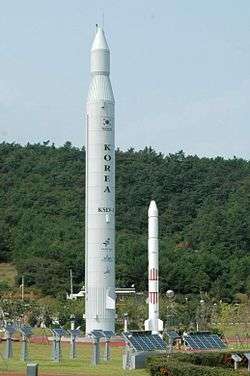Korea Aerospace Research Institute
The Korea Aerospace Research Institute (KARI) established in 1989, is the aeronautics and space agency of South Korea. Its main laboratories are located in Daejeon, in the Daedeok Science Town. KARI's vision is to continue building upon indigenous launch capabilities, strengthen national safety and public service, industrialize satellite information and applications technology, explore the moon, and develop environmentally-friendly and highly-efficient cutting-edge aircraft and core aerospace technology. Current projects include the KSLV-2 launcher. Past projects include the 1999 Arirang-1 satellite. The agency was founded in 1989. Prior to South Korea's entry into the IAE in 1992, it focused primarily on aerospace technology.
한국항공우주연구원 | |
 | |
 | |
| Agency overview | |
|---|---|
| Abbreviation | KARI |
| Formed | October 10, 1989 |
| Type | Space agency |
| Headquarters | Daejeon, Republic of Korea |
| Motto | Aerius Spatium [1] |
| Administrator | Lim, Cheolho (임철호) |
| Primary spaceport | Naro Space Center |
| Owner | National Research Council of Science & Technology |
| Annual budget | ₩ 688.8 billion; $583 million FY2016[2] |
| Website | KARI |
Background
KARI began on October 10, 1989 as a national aerospace research institute with the purpose of contributing to sound development of the national economy and enhancement of people's lives through a new exploration, technological advancement, development, and dissemination in the field of aerospace science and technology.[3]
KARI began in 1989 to develop its own rockets. It produced the KSR-I and KSR-II, one and two-stage rockets in the early 1990s.
In December 1997 it began development of a LOX/kerosene rocket engine. KARI wished to develop satellite launch capability. A test launch of the KSR-III took place in 2002.
Timeline
- 1989.10 Establishment of KARI affiliated to Korea Institute of Machinery & Materials (KIMM)
- 1990.12 Cornerstone – Laying ceremony for the building of the institute
- 1992.07 Authorized as the Inspection Agency, designated by the AIDP Law
- 1992.10 Completion of construction of the research building complex
- 1993.04 Experimental Aircraft Kachi Development
- 1993.06.09 Launch of Single-stage Sounding Rocket (KSR-I)
- 1993.09 EXPO Unmanned Airship Development
- 1995. Korea launched its first communications satellite named Koreasat * 1996.11 Independent organization as KARI, an Incorporated Foundation
- 1997.03 Twin-engine composite Aircraft Development
- 1997.04 Authorized as the Type Certification Agency, designated by the Aviation Law
- 1998.06 Launch of Two-stage Sounding Rocket (KSR-II)
- 1999.01 Change of Type Certification Agency
- 1999.12 Launch of Korea Multiple Purpose Satellite (KOMPSAT I) also known as Arirang I
- 2001.01 Change of name to Korea Aerospace Research Institute
- 2001.09 Canard Aircraft Development
- 2002.11 Launch of Liquid-propellant Rocket (KSR-III)
- 2003.05 Cornerstone – laying ceremony for the Aircraft Flight Test Center
- 2003.08 Cornerstone – laying ceremony for the NARO Space Center
- 2003.09 Launch of STSAT (Science and Technology Satellite)-1[4]
- 2003.10 Multi-Purpose Stratosphere unmanned-airship Development
- 2004.10 Completion of Jeju island Tracking Station
- 2005.01 Installation of South pole ground station
- 2006.07 Launch of Korea Multi-Purpose Satellite (KOMPSAT 2) also known as Arirang II
- 2008.03 Transfer to Korea Research Council of Fundamental Science & Technology (KRCF)
- 2008.04 The first Korean astronaut
- 2008.12 Medium Aero stats Development
- 2009.06 Completion of NARO Space center
- 2009.08 The 1st launch of Korea's 1st space launch vehicle KSLV-1
- 2010.06 Launch of COMS
- 2010.06 The 2nd launch of Korea's 1st space launch vehicle KSLV-1
- 2011.11 Smart UAV Development
- 2012.05 Launch of Korea Multi-Purpose Satellite(KOMPSAT)-3
- 2012.06 Korean Utility Helicopter Surion Development
- 2013.01 The 3rd launch of Korea's 1st space launch vehicle KSLV-1
- 2013.08 Launch of Korea Multi-Purpose Satellite (KOMPSAT)-5
- 2013.11 STSAT(Science and Technology Satellite)-3 Development
- 2013.12 4KC-100 Development
- 2014.05 OPV Development
- 2014 Research on lunar exploration cooperation began
- 2015.03 Launch of Korea Multi-Purpose Satellite (KOMPSAT)-3A
- 2015.08 EAV-3 development
- 2015.12 The completion of KSLV-II's engine combustion test facility
- 2016.12 Designated as a National Space Development Agency
- 2018.11 Launch of Test Launch Vehicle(TLV)
- 2018.12 Launch of GK-2A(GEO-KOMPSAT-2A)
Aerospace developments

KARI is also developing Unmanned Aerial Vehicles, high-altitude airships, a next-generation multi-purpose helicopter project, next- generation medium satellite, and a lunar exploration project. In addition, several satellites, including the KOMPSAT (also known as Arirang) Series, the COMS (Communication, Ocean and Meteorological Satellite), and the STSAT (Science and Technology Satellite), are developed, operated, or under development by KARI. On January 30, 2013, they launched a satellite into space from their own soil for the first time.[5]
Mission and Major Functions
- Perform basic and applied studies in aerospace technology
- Development of leading-edge technology aircraft, aircraft evaluation and testing, and support of national development projects
- Research and development of comprehensive system and core technology of aircraft, satellite, and space launch vehicle
- Support national aerospace development policy establishment, distribution, and diffusion of aerospace technology information
- Development and KSLV(Korea Launching of Space Launch Vehicles) and Operation of Space Center
- Perform government-delegated tasks and support policy development
- Development of technology for assuring aerospace safety and quality, and maintenance of legal quality certification and internationally recognized certification systems
- Establishment and support of the National Aerospace Development Policy and dissemination of knowledge on aerospace technology
- Support industries and transfer technology
- Joint utilization of testing facilities and equipment with industries and academia, and training of scientists and engineers
- Transfer of technology from research and development and provisions for commercialization support
Space Launch Vehicles
KSLV-1 and KSLV-2
KSLV-1 launched on August 25, 2009. It was originally a cluster indigenous liquid KSR-III rockets with a solid propellant to form a multistage launcher. However, KARI experienced more difficulties than expected in SLV development, because it required much stronger propellant power than KSR-III possessed to launch a satellite into orbit.[6] After several failed attempts, KARI turned to Russia's Khrunichev Design Bureau for assistance in developing a liquid-propellant rocket engine for the KSLV-1 as well as for cooperation in the construction of the launch facility at the Naro Space Center. KSLV-1 was transformed into a two-stage launcher, 33 m high with a maximum diameter of 2.9 m. It has a mass of 140 tons at lift-off. The first stage of the launcher was derived from the Russian URM-1 (Universal Rocket Module) developed by Khrunichev. The second stage of the launcher was a solid Kick Motor developed by Korea, which includes the Inertial Navigation System; the power, control, and flight safety systems; plus the nose fairing. KSLV-1 was the most prominent project of the whole South Korean space development program and was successfully launched in late January 2013.[6] South Korea is planning to launch its next rocket KSLV-2 by year 2021. The first stage of its rocket will have 4 clustered engines, each of which will have a 75 metric ton thrust. It was announced that KARI has already developed few prototypes of a 75 metric ton thrust engine.
KSLV-2 TLV
The Test Launch Vehicle (TLV) is a one stage rocket used to test the performance of the 75-ton thrust rocket engine that will power the KSLV-2. The TLV is 25.8 meters in length, 2.6 meters in diameter, and with a mass of 52.1 tons. The main-stage Kerolox engine is fully gimballed.[7][8]
KRE-075 Engine
| Fuel | RP-1/LOX[9] |
| Thrust | 75 metric tons |
| Specific Impulse | 298s |
| Height | 2.9m |
| Diameter | 2m |
Test flight #1
| Wet Mass | 52.1t[9] |
| Dry Mass | 38 tons |
| Height | 25.8m |
| Diameter | 2.6m |
| Stages | 1 |
| Engine | KRE-075 |
The first TLV was launched from the Naro Space Center in Goheung, South Jeolla Province. The main objective of the first suborbital flight was for the single-stage rocket's main engine to burn 140 seconds, reaching a 100 km altitude before splashing down in the sea between Jeju Island and Okinawa Island.[10]
The maiden flight was first delayed from October 25, 2018, for two months, due to abnormal readings detected in the rocket propellant pressurization system.[11] The test flight was then rescheduled for November 28, 2018, at 16:00 KST(UTC+9). No payload is to be placed into orbit.[12]
The launch of the first TLV while deemed successful with its main engine burning for 151 seconds in a 10-minute flight,[13] was not broadcast live.[14] After reaching a maximum suborbital altitude of 209 kilometers, the rocket stage hit the ocean 429 kilometers southeast of Jeju.[15]
Korean Lunar Exploration Program
In December 2016, KARI signed a lunar exploration technical cooperation with NASA which increased the possibility of exploration success greatly. The Korean Lunar Exploration Program (KLEP) is divided in two phases.[16][17] Phase 1 incorporates the launch and operation of a lunar orbiter called Korea Pathfinder Lunar Orbiter (KPLO), which will be the first lunar probe by South Korea,[18] meant to develop and enhance South Korea's technological capabilities, as well as map natural resources from orbit. Phase 2 will include a lunar obiter, a lunar lander, and a rover[19] to be launched together on a KSLV-II South Korean rocket from the Naro Space Center,[20][16] by 2030.[21][22]
Satellite Navigation
KASS is the Korean model of satellite-based augmented systems (SBAS), a technology that is capable of reducing GPS error to less than 3m. Korea is expected to become the only seventh country in the world to own an SBAS, beginning in October 2022.[23]
Korea Multiple- Purpose Satellite-3A
Korea Multiple-Purpose Satellite- 3A (KOMPSAT-3A) was launched on 25 March 2015, on a Dnepr-1 launch vehicle from the Jasny Kombarovsky site in Russia. The purpose of the KOMPSAT-3A is to enable us to take advantage of geographical information systems (GIS) in environmental, agricultural, and oceanographic sciences, and to facilitate responding to natural hazards. The KOMPSAT-3A is equipped with two distinctive sensors, a high-resolution multi-spectral (MS) optical sensor, namely the Advanced Earth Image Sensor System-A (AEISS-A), and the Scanner Infrared Imaging System (SIIS).[24]
Smart Tilt Rotor UAV
In late 2011, KARI unveiled its tiltrotor Unmanned Aerial Vehicle (UAV) that can fly at around 400 km/hr.
See also
- Naro Space Center
- Korean Astronaut Program
- List of aircraft manufacturers
- List of Korea-related topics
- Government of South Korea
- List of government space agencies
- Naro-1
References
- Latin for "Aerospace" "Archived copy". Archived from the original on 2011-09-27. Retrieved 2007-11-08.CS1 maint: archived copy as title (link)
- "기관별 경영공시 한국항공우주연구원". alio.go.kr. Archived from the original on 2016-06-24. Retrieved 2016-05-25.
- Greeting address. (2016). Korea Aerospace Research Institute. retrieved from https://www.kari.re.kr/eng/sub01_01.do
- "History". Korea Aerospace Research Institute. Retrieved 7 May 2017.
- "South Korea launches rocket weeks after NKorea". The San Diego Union-Tribune. January 30, 2013. Retrieved 2013-02-01.
- An, H. (2013). Seeking independence in space: South korea's space program (1958–2010). Quest: History Of Spaceflight, 20(2), 34–51.
- 10 Sep 2018 (2018-09-10). "한국항공우주연구원 on Twitter: "올 10월로 다가올 #시험발사체 조립 장면 타임랩스 영상으로 만나 보시죠!… "". Twitter.com. Retrieved 2019-01-10.
- "사진 > KARI IMAGE >". www.kari.re.kr. Retrieved 10 January 2019.
- https://i.servimg.com/u/f48/19/39/35/83/scree261.jpg
- 김한주 (28 November 2018). "S. Korea to test launch space rocket engine". Yonhap News Agency. Retrieved 10 January 2019.
- "S. Korea delays test launch of space rocket engine". English.yonhapnews.co.kr. 2018-10-17. Retrieved 2019-01-10.
- 한국항공우주연구원 (13 November 2018). "11월 28일, 한국형발사체 '누리호'의 엔진시험을 위한 시험발사체 발사가 추진될 예정입니다.pic.twitter.com/9eOHhufcym". twitter.com. Retrieved 10 January 2019.
- 김한주 (28 November 2018). "(2nd LD) Space rocket engine burn time test meets target goal". Yonhap News Agency. Retrieved 10 January 2019.
- 한국항공우주연구원 (27 November 2018). "#시험발사체 발사 성공! 발사 모습을 영상으로 공개합니다.pic.twitter.com/lTkonvL7ax". twitter.com. Retrieved 10 January 2019.
- 김한주 (28 November 2018). "(2nd LD) S. Korea successfully tests space rocket engine". Yonhap News Agency. Retrieved 10 January 2019.
- Korean Lunar Exploration Program. Korean Aerospace Research Institute (KARI). Accessed on 25 January 2019.
- SpaceX selected to assist 2020 South Korean lunar orbiter voyage. Lee Keun-young, Hankyoreh. 30 December 2017.
- KPLO. Lunar Exploration Program. Korea Aerospace Research Institute (KARI). Accessed on 25 January 2019.
- Korean Pathfinder Lunar Orbiter (KPLO) Status Update. (PDF) Korea Aerospace Research Institute (KARI). 10 October 2017.
- South Korea's first lunar mission planned for 2020. Emily Lakdawalla, The Planetary Society. December 7, 2017.
- Pak, Han-pyol (1 July 2013). "핵전지 실은 한국형 로버 … 지구서 우주인터넷 통해 조종". 중앙일보. Retrieved 19 July 2013.
- Kim, Jack (20 November 2007). "South Korea eyes moon orbiter in 2020, landing 2025". Reuters. Retrieved 25 January 2019.
- "Satellite Navigation > R&D >". www.kari.re.kr. Retrieved 10 January 2019.
- Yeom, J., Hwang, J., Jung, J., Lee, K., & Lee, C. (2017). Initial Radiometric Characteristics of KOMPSAT-3A Multispectral Imagery Using the 6S Radiative Transfer Model, Well-Known Radiometric Tarps, and MFRSR Measurements. Remote Sensing, 9(2), 1. doi:10.3390/rs9020130
External links
- KARI official website (Korean / English)
- South Korean space projects from Encyclopedia Astronautica